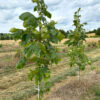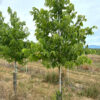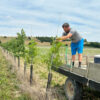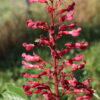You cannot grow quality native trees if you do not have good soil. At White House Natives [WHN], we invest in building up our soils with cover crops to add organic matter and nutrients to our soil, along with several other stewardship practices. We utilize several cover crop options, each having their own benefits. We use fescue (Festuca spp.) in drive roads, white clover (Trifolium repens) in spacing rows in planted fields; crimson clover (Trifolium incarnatum) in resting fields; and a fall/winter rotation of turnips (Brassica rapa ssp. rapa), radishes (Raphanus raphanistrum ssp. sativus) and rye (Secale cereale) along with a summer rotation of buckwheat (Fagopyrum esculentum) in fields to be planted the next season. There are many benefits to buckwheat as a summer cover crop as it establishes quickly, suppresses weeds, and can be easily tilled back into the soil prior to fall planting. One of the best benefits of buckwheat is the habitat it provides for insects and pollinators especially bees since it starts to bloom four weeks after planting and continues for several weeks. When in full bloom, buckwheat puts on quite a show of white flowers all while enhancing our soils. Together, these cover crops help ensure our annual plantings of native trees can thrive for the 3-6 years they are being crafted into specimens that will find homes throughout the mid-Atlantic region. Photos taken May and June 2023.
Prev
 0
0
At the Nursery: Late Spring Inventory Overview, Part 3
06 July 2023
Next
 0
0
At the Nursery: June Inventory Overview, Part 1
24 July 2023





